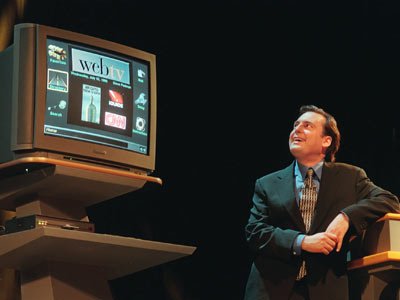The perils of television
 Television nearly killed me. Here’s how it happened.
Television nearly killed me. Here’s how it happened.
For several years in the 90s in Boston, I ran a group called the Multimedia Roundtable. It was a little developer group that eventually swelled to a lively 300 people. It met monthly at 6:00pm in a big room in Cambridge in the building of Course Technology, where I used to work. I kept the meetings there even after I started working at Forrester Research, which was about 15 minutes away.
Anyway, one evening I had planned to do a meeting about WebTV, which was a new thing: a device that brought you the internet (dial-up) on your TV set. I had advertised that I would be doing a demo.
An hour before the meeting, at 5:00, I wheeled in a big TV set that I’d borrowed from Course Technology, connected it to the WebTV, dialed out . . . and got nowhere. I futzed with it for 40 minutes. I began to panic. Something was wrong between the TV and the device. But I knew that the WebTV worked with a different TV — the one I’d tested it on at Forrester.
I quickly drove down the road to Forrester and retrieved from he TV that I’d tested earlier that afternoon, which was in a third-floor closet. It was a big honking thing (about 50 pounds — this was the CRT era). I didn’t have permission to take it, but who would know — I’d be back with it before the end of the night. I also grabbed a couple of cables that I thought might be useful.
In a rush, I wrestled the monster into the elevator, set it down, and pushed the button for the ground floor.
The elevator doors closed.
At that moment, I looked down. The TV power cord led to the seam between the closed elevator doors. The plug was on the other side. And unlike many TVs and devices today, the cord was permanently connected to the back of the TV set.
I frantically pushed the door-open button which, of course, did nothing.
As Newton says, for each action, there is an equal and opposite reaction. The elevator began to descend. A the same time, the cord slid upward between the closed doors, eventually reaching the top of the elevator.
The cord began pulling upward further, eliminating all the remaining slack coiled within the elevator. It became taut, then began to stretch. This all took about 15 seconds, but it felt to me as if it was happening in slow motion.
The heavy TV began to lift up off the floor of the elevator, pulled by its own cord. For a moment, it levitated about three feet off the ground. I knew something very bad was about to happen.
Then there was a loud whip-cracking sound, and the TV fell back to the ground with a sickening thud. I escaped injury by jumping out of the way at the last moment.
The elevator reached the ground floor. The doors opened. And now I could see that the other end of the cord was a frayed mess.
As rapidly as I could, I took the elevator back to the third floor and returned the TV to the closet. I then rushed back to my car and got back to the meeting, about 15 minutes late. About 100 people were in the room, buzzing excitedly.
As coolly as possible, since I was covered in sweat, I took charge of the meeting and handed the spare cable to a friend that I knew was talented with electronics. I led a discussion while my friend tinkered with the technology. About 10 minutes later, my friend had gotten the demo working. I ran the demo.
Several days later, laden with guilt, I got a replacement plug from Radio Shack and attached it to the end of the power cord on Forrester’s TV. The color didn’t match. The TV looked and worked fine, however, except for a few scratches on the side.
Later that month, someone from Forrester showed a video at a company meeting. Everyone else watched the video. I watched my feet. No one noticed anything wrong with the TV. Or the odd scrapes on the elevator doors, for that matter.
I’ve carried that guilt for 20 years. No TV has tried to kill me since. Now that they’re flat panels, they’re a lot less dangerous.
Photo: WebTV founder Steve Perlman via Business Insider
“Television nearly killed me. Here’s how it happened.”
Bullshit.
Hyperbole.
Linkbait? Intelligent linkbait?
Guess that was in the days before surveillance cameras in elevators. Pity.